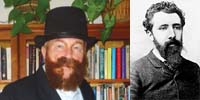
Young takes the stage, in costume and with visual aids, as the highly innovative 19th century painter Seurat. The artist employed the science of optics and color to create the perception of brilliant colors that appeared solid when in fact they were composed of thousands of tiny dots of paint. Seurat did not mix his paint on a palette and apply with brush strokes as did his contemporaries. His paintings were created with thousands of dots of paint. Seurat was intrigued by and studied the science of optics, learning that the eye will blend individual dots of color to create another color. He called his technique, which he had researched extensively from available writers on the science of optics, “divisialism.”
Cosponsored by the Friends of the Idyllwild Library and the Idyllwild Community Recreation Council, Young’s performance as Seurat concludes what for him has been a second career as a touring performance artist.
“I’ll continue my performances, but just no longer on tour,” said Young, who plans to continue painter impersonations as part of courses he will teach in Northern California beginning in July.
Young’s performance art began as an attempt to draw his high school students into the lives and psyches of famous painters, who often lived fascinating, compelling and idiosyncratic personal lives.
But lectures and slides did not do it. Students still remained impassive and disinterested until one day, unannounced, Young showed up in class in full costume as Vincent Van Gogh. Young talked, as if he were Van Gogh, about his loneliness and isolation and how that played out in and influenced his art. At the end of the class, his students stood and applauded. Young knew he was on to something valuable both in the classroom and later, after he retired as a teacher, on the road as a performance artist.
Audiences will find Seurat an interesting subject — an iconoclast — who devised a new way of painting, combining science and art. The Paris art establishment initially shunned him because of these nontraditional methods, use of working class subjects and his inclination to paint on overly large canvases. But especially it was his belief and method of combining science and art that contemporaries found off-putting. Other artists nicknamed him, in a not flattering way, as the “mad scientist.”
Seurat’s early, somewhat mysterious death, at the age of 31, was followed shortly thereafter by the death of his wife and young son, probably from the same illness. Much of his life remains unknown.
Perhaps his best known work, in the permanent collection of the Art Institute of Chicago, is “A Sunday Afternoon on the Island of La Grade Jatte.” This pointillist masterpiece shows members of a disparate mix of social classes mingling on a sunny summer afternoon at a popular Parisian gathering place.
The painting was the inspiration for Stephen Sondheim’s musical “Sunday in the Park with George,” that had successful runs in London and on Broadway. Sondheim’s lyrics have Georges constantly referring to the importance of “science and art,” as his way of working and his muse.
Seurat was dedicated to proving that a painter could use color to create harmony and emotion in much the same way as a musician uses counterpoint and variations to create harmony in music. He believed that application of optical laws could be used to create a new language of art. Seurat once wrote, “Art is harmony. Harmony is the analogy of the contrary and of similar elements of tone, of color and of line, considered according to their dominance and under the influence of light, in gay, calm or sad combinations.
Although not universally admired within the Paris art salons, Seurat had his followers. One, Paul Signac, wrote of him, “He surveyed the scene and had made these very important contributions: his black and white, his harmony of lines, his composition, his contrast and harmony of color, even his frames. What more can you ask of a painter?”










